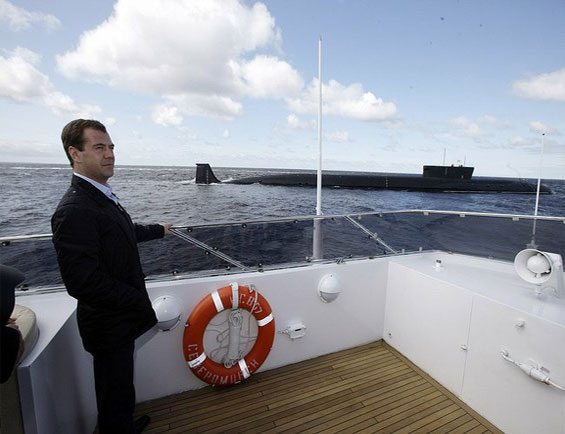
Voters Will Pay For a Military Buildup After Electing Putin
Publication: Eurasia Daily Monitor Volume: 8 Issue: 213
By:

Defense and security spending is skyrocketing in Russia. Paychecks for defense and interior ministry personnel will increase 2.5 to 3 times from January 2012, while Federal Security Service (FSB) and the Federal Protective Service (FSO) staff will receive a similar pay boost in January 2013. According to the Finance Minister, Anton Siluanov, “An additional trillion rubles ($32.7 billion) has been allocated to cover the increase in defense and security personnel pay in the next two years” (https://premier.gov.ru/events/news/17091, November 14). The massive pay increase is being matched by growing defense procurement and operational costs. According to Prime Minister Vladimir Putin, “in 2011 defense procurement was 750 billion rubles ($24.5 billion) which is 1.5 times more than in 2010, and in 2012 it will reach 880 billion rubles ($28.8 billion).” During a special meeting on defense procurement this week in Moscow, Putin declared: “These substantial budgetary disbursements must create powerful integrated air, sea, land and antiaircraft forces.” The joint work of government, the military and defense industry is essential to achieve the goal of Russian rearmament, according to Putin (https://premier.gov.ru/events/news/17092, November 14).
According to the three-year budget plan earmarked for approval in the State Duma, fully controlled by the ruling United Russia party, defense, federal police and security services expenditures in 2014 may reach 40 percent of the national budget (at present it is 27 percent). Official defense spending may reach five percent of GDP in 2014 with the militarized security services and the interior ministry gobbling up another four percent of GDP. Experts, including the former Finance Minister Alexei Kudrin, say that Russia is being transforming into a militarized police state and the general public will pay the bill: budgetary expenditure on public health, education and culture will be significantly cut. After the Duma elections next month that will surely be rigged like previous ones to produce a United Russia landslide and the re-election of Putin to the Kremlin for a third six year term as president next March, the population will begin to feel the pinch as essential consumer prices and utility tariffs are unfrozen. According to the former senior government official, Yevgeny Gontmakher, the Russian defense industry is a colossal black hole that keeps sucking in vast amounts of money from the budget without producing the desired results – “it seems with this budget plan the authorities are testing society to its breaking point” (Nezavisimaya Gazeta, November 16).
Defense procurement in Russia is covered by a blanket of state secrecy and it is impossible for the taxpayers to understand or control virtually anything. Last week, Putin oversaw in Severodvinsk, near Arkhangelsk, the signing of major defense contracts to procure and design new nuclear submarines that were intended to end a long running conflict between the defense ministry and the state-run United Shipbuilding Corporation (USC) on pricing (EDM, November 10). This week, Putin disclosed that when he arrived in Arkhangelsk, the defense ministry and USC were still deadlocked, so he was forced to become involved in severe hand twisting to secure the signing. Putin announced the creation of a special interdepartmental working group to oversee the forming of defense industry procurement prices and the execution of defense contracts “all down the line.” According to Putin, “We have allocated 20 trillion rubles ($654 billion) to rearm our military by 2020 and we cannot spend any more, but if we continue to work in the present mode, we will fail to achieve our goal in this most important government task” (https://premier.gov.ru/events/news/17092, November 14).
Russian rearmament plans are indeed formidable. The Pacific Fleet is being seriously revamped to be able to face the joint naval forces of the US and Japan. At present, the Pacific Fleet has been reduced to 49 surface ships and 22 submarines, among which less than 20 surface ships and 16 submarines are considered seaworthy and many of these require maintenance and renovation. Investments in Pacific Fleet infrastructure are growing and reinforcements are planned to arrive. The first two Borei strategic nuclear submarines – Yuri Dolgoruky and Alexander Nevsky – armed with new Bulava multiple-warhead ballistic missiles are scheduled to arrive imminently in Kamchatka at the Vilyuchinsk submarine base, where housing and infrastructure have been revamped on orders from the Kremlin. A contract has been signed under Putin’s supervision last week in Severodvinsk to refurbish the large Cold War era built Admiral Hakhimov nuclear cruiser and move it from the Barents Sea to the Pacific Fleet together with the missile cruiser Marshal Ustinov (www.gazeta.ru, November 2).
The Borei submarines will go on patrol in the Russian-controlled Sea of Okhotsk to target from there the continental US. The cruisers will enhance the capability of the Pacific Fleet to attack US carrier groups. New Russian tanks, attack helicopters, anti-ship and antiaircraft missiles are scheduled for deployment in the southern Kurile Islands that Japan claims as its own. In Honolulu, Hawaii, at the Asia-Pacific forum summit, President Dmitry Medvedev announced that the military deployment in the southern Kuriles is purely for defense and the Japanese are welcome to invest in the development of the South Kurile Islands “together with Russia,” without any prospect of gaining sovereignty (Interfax, November 11).
The southern Kuriles are a key forward position on the southern boundaries of the Sea of Okhotsk, essential to ensure the security of the deployment of the new Borei strategic ballistic submarines that deter the US and its allies against infringement of the Russian territorial sphere of influence within the post-Soviet space. But developing and sustaining the southern Kuriles is an additional money drain in addition to the investment needed to boost and rearm the Pacific Fleet. Defense spending seems to be massively misappropriated and the Russian budget is full of “black holes.” Pouring in good money after bad will not help as the derelict Russian defense industry is severely limited in its capability to produce larger quantities of better quality weapons and seems to respond to increased procurement budgets mostly by inflating prices. Putin’s remedy to create additional supervisory bureaucratic entities to control and streamline defense spending, while keeping all the proceedings under a veil of secrecy, seem futile as is the hope of accessing Japanese or any other Western money to develop the southern Kuriles into an economically sustainable military stronghold in the region.




